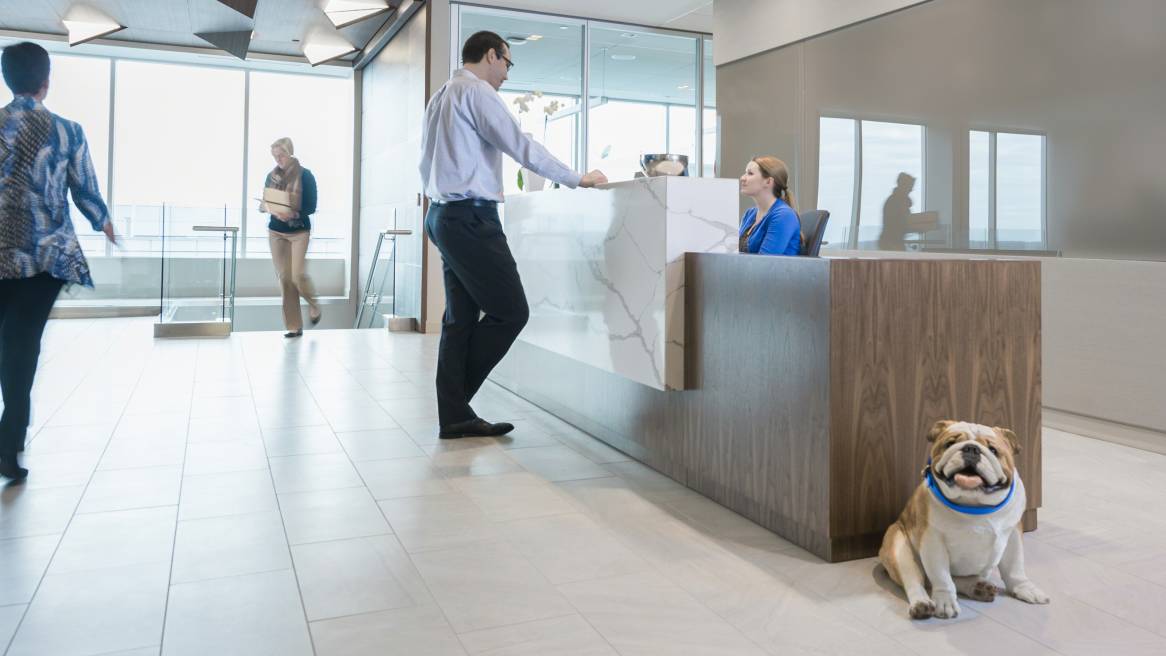Womble Carlyle: Workplace Redesign
Womble Carlyle, a 140-year-old law firm with offices across the Southeast, Mid-Atlantic and Silicon Valley is known for embracing new technology and advising clients on cutting edge legal issues.
Raising the Bar of Workplace Performance
Womble Carlyle, a 140-year-old law firm with offices across the Southeast, Mid-Atlantic and Silicon Valley is known for embracing new technology and advising clients on cutting-edge legal issues.
Their new Raleigh, NC office reflects their leadership position. It’s a high performance workspace that helps improve employee wellbeing and conveys an image befitting a top tier law firm, yet uses less real estate than their old office.
“The pressure on law firms and other service providers to hold rates steady and be more efficient is immense. Since the economic downturn our clients have had to be more efficient, and they expect us to be more efficient, too,” says Johnny Loper, managing partner. “Our new space allows us to work better both individually and collaboratively.”
Anticipating their office lease expiration, Womble Carlyle leadership sought a work environment that would contribute more to the success of the firm. They worked with Steelcase to survey the firm’s staff and developed a list of key needs for the new office, including:
- better support for the firm’s work processes
- more support for focused work
- support for working in different postures
- spaces that support collaborative and contemplative work
- improved methods for layering, displaying and storing information
Womble Carlyle worked with Interior Architects and Storr Office Environments to create a new workplace in a building not far from their old location, but worlds apart in terms of performance. No longer is the firm spread over three non contiguous floors; it’s now on two connected floors with shared spaces available to all staff.
60 Attorneys, 1 Office Size
The new work environment reflects changes in the legal profession, such as rising real estate costs, increasing collaboration in legal processes and generational changes in the workforce. For example, prestige and accomplishment used to be reflected in a lawyer’s office size. No longer. Each lawyer’s office at Womble Carlyle is the same size, 10 ft. x 15 ft., but smaller than their old offices.
This marks a paradigm shift in a profession built on tradition and precedent, and requires an adjustment for attorneys long accustomed to striving for a “partner office.” But as Keith Arnott, director of facilities points out, “our attorneys now have furniture that better supports how they work, furniture they can reconfigure and adjust to exactly what they need. They can do more in less space.”
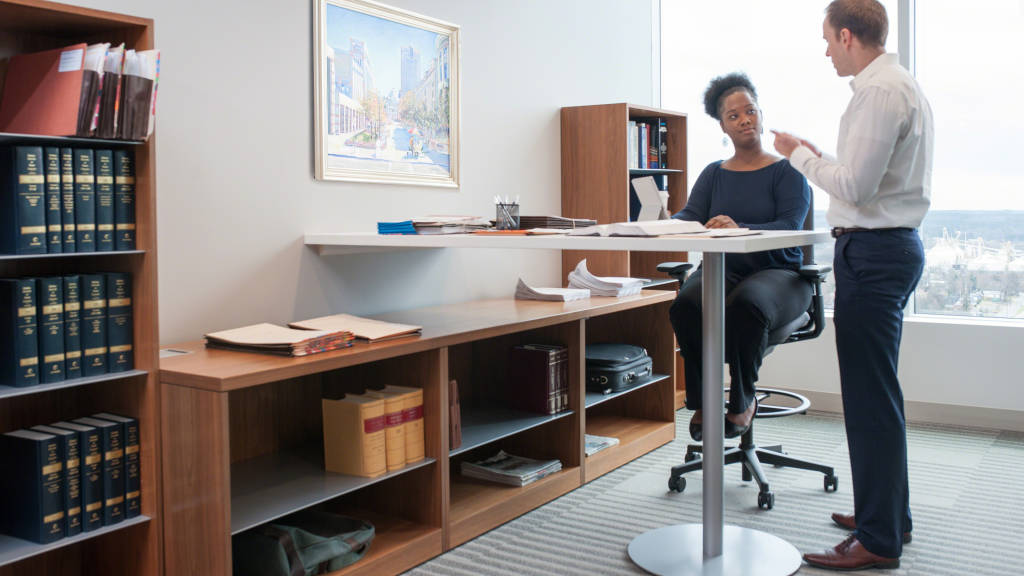
“Our attorneys now have furniture that better supports how they work. They can do more in less space.”
Keith ArnottDirector of Facilities, Womble Carlyle
The offices feel larger than their footprint, thanks to an exterior view and V.I.A. demountable glass walls along the interior. The walls share daylight with the rest of the floor, encourage more transparency and collaboration with colleagues, while providing true acoustical privacy.
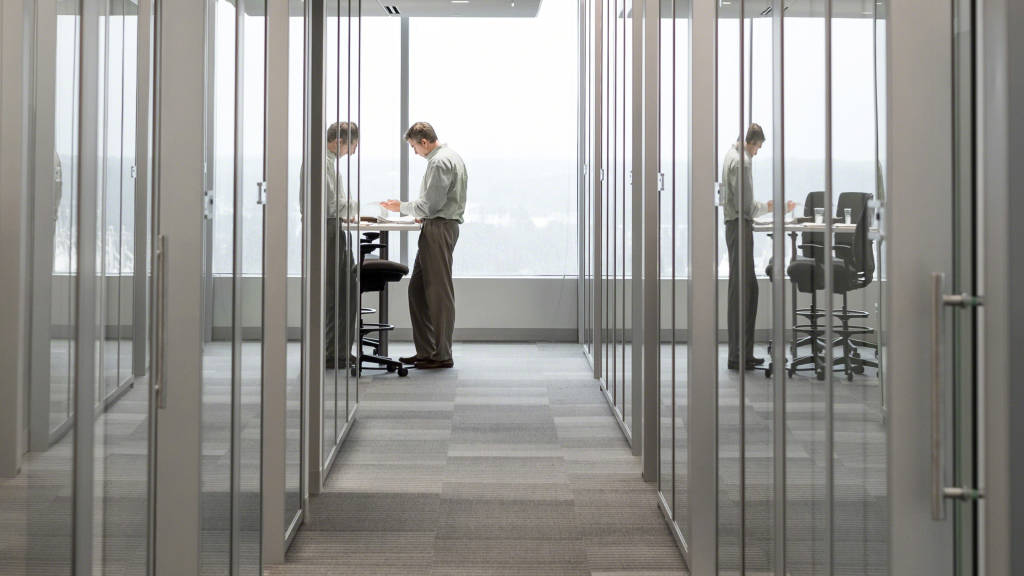
Elective Elements freestanding furniture can be arranged in different ways and customized with storage and worktools options to support each lawyer’s workstyle preferences.
V.I.A. and the Elective Elements furniture work seamlessly together and support Womble Carlyle’s design directive to create “a refined, timeless and contemporary aesthetic with a light and inviting look and feel.”
Legal assistants, previously in open workstations, have enclosed offices, just as paralegals do. Doors can be closed during confidential phone calls or for more privacy during focused work. Offices for the legal assistants and paralegals have the same furniture application to provide future flexibility.
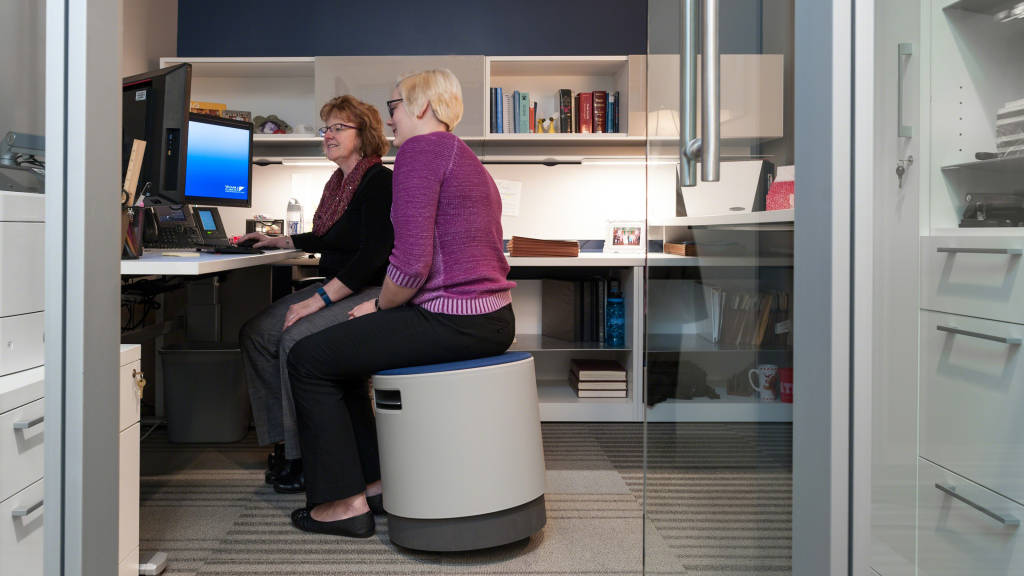
A decade ago it was not unusual for one legal assistant to support one, perhaps two attorneys. Today, one assistant supports four, and Womble Carlyle expects that ratio to continue to trend upward. That’s why the assistant and paralegal offices support varied work processes and workstyles, and help users to better engage with their work.
Consistent office footprints and furniture present another long-term benefit: the inevitable moves and changes are handled faster and easier.
A Higher Quality Work Life
While overall square footage has been reduced, the quality of work life has been enhanced. Every staff member has a height-adjustable worksurface and a Gesture or Amia ergonomic chair, to boost employee wellbeing, support and comfort. “We wanted to encourage people to move and change postures throughout the day and to collaborate more, and the adjustable-height worksurfaces have been a phenomenal hit. Walk around the office and you’ll see a third to half of our employees standing at any time,” says Christine Peterson, director of administration.
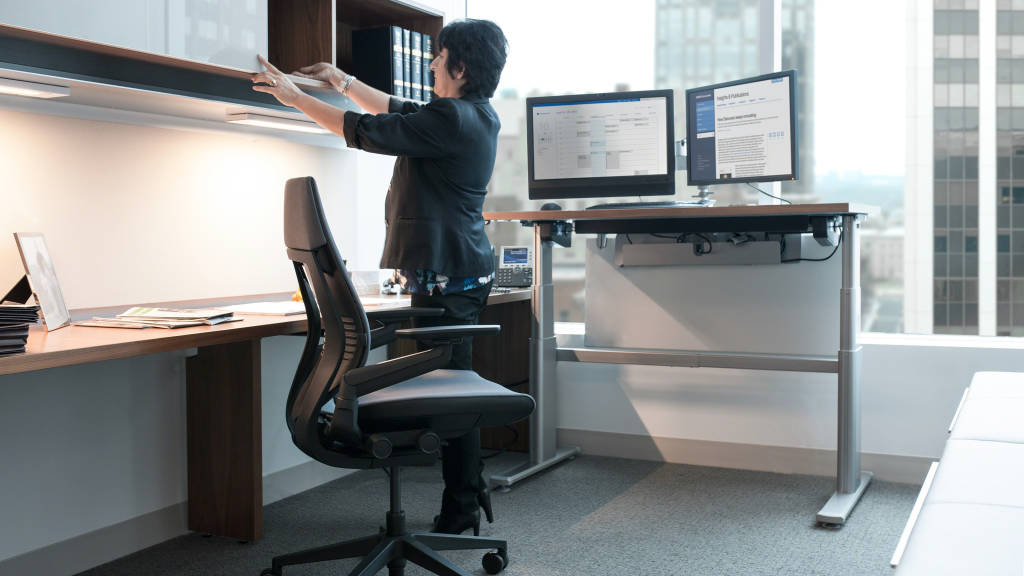
Law offices typically have piles of files and materials heaped everywhere. At Womble Carlyle, workspaces offer a variety of different vertical and horizontal surface options so print materials are easily organized and more accessible. Adjustable monitor arms allow users to position screens for comfortable viewing of digital information.
There’s also better support for collaborative work. Conference rooms for long-term legal cases, for example, include casual and formal meeting spaces and both seated and standing work areas. “People working on long-term projects can get up and move around, and they have different places for working, such as lounge chairs where you can sit back and read a long brief,” says Peterson.
The firm’s new café encourages collaboration and camaraderie. It’s centrally located along a window and includes small group collaboration areas and a coffee bar. “On the very first day we moved in, two people who had worked on different floors in the old building introduced themselves to each other in the café. It was the first time they’d met,” says Arnott.
Proving Their Case
“There is an authenticity about their new work environment that represents them well,” says Sheri Ginett, who was the project lead for Interior Architects. “It’s modern with a touch of the traditional. It’s not extravagant or opulent; it’s the right space for a hardworking law firm.”
Johnny Loper sees benefits inside and outside the firm. “The space is more efficient, which our clients love because there’s less pressure on rates. We love this new workplace because it allows us to perform at a higher level, to work better both individually and collectively.”
The new workplace “allows us to perform at a higher level, to work better both individually and collectively.”
Johnny LoperManaging Partner, Womble Carlyle
One month after move-in, a follow-up survey asked Womble Carlyle staff to evaluate the new workplace and how well it met the needs they had identified as important to their work processes and workstyles.
Overall satisfaction with the workplace, on a scale of 1 to 7, took a significant jump, from 5.06 in the old offices to 6.17 in the new work environment.
Satisfaction levels with specific workplace factors also show major improvement. (Note: overall workplace satisfaction was measured on a 7-point scale; issues requiring less specificity, such as the workplaces needs below, were measured on a 5-point scale.) Some typical results:
| Identified Workplace Need | Old Office (scale 1-5) | New Workplace (scale 1-5) |
| Support for contemplative work | 3.40 | 3.93 |
| Support for focused work | 3.43 | 4.07 |
| Support for multiple postures | 2.37 | 4.48 |
| Ability to stack and layer information | 2.95 | 3.88 |
| Ease of sharing documents + information | 3.51 | 3.98 |
| Moving quickly between individual + group work | 3.19 | 3.79 |
Comments from Womble Carlyle staff mirror the survey results. A sampling:
- “Plenty of ‘real estate’ and desk space to lay out documents, books, etc. Great computer monitor set up.”
- “There is a lot more storage than I had anticipated. I’ve been able to organize files in different locations and am pleased with how much actually fits in my office!”
- “I absolutely love the adjustable-height desk and often work standing. The ease with which I can go back and forth from my computer (when I’m standing) to the work table behind me and my printer makes my work transitions feel so much smoother.”
- “I love the furniture and the layout. I love the glass and the light. I love the closing door. I love the upholstered benches/cabinets for groups.”
Managing partner Johnny Loper appreciates the counsel his firm received. “We’re lawyers, and while we think we can learn any subject if we’re required to, we were smart enough to team up with good people on this project. We appreciate their good advice, their products, and their patience,” says Loper. “As a result, we have a great work environment.”
Measuring workplace performance
| Old | New |
| 67,000 sq. ft. | 43,000 sq. ft. |
| 3 noncontiguous floors | 2 consecutive, connected floors |
| Various office footprints | Consistent office sizes: – 10 x 15 attorney offices – 10 x 10 staff offices |
| Minimal adjustability | Adjustability for all users: – height-adjustable worksurfaces – adjustable monitor arms – multiple worksurface options – ergonomic seating |
| Limited flexibility | Built-in adaptability: – user choice and control of workspace – freestanding, movable furniture – demountable walls – consistent furniture applications for easier moves and changes |
Credits
Designer: Interior Architects
Dealer: Storr Office Environments

